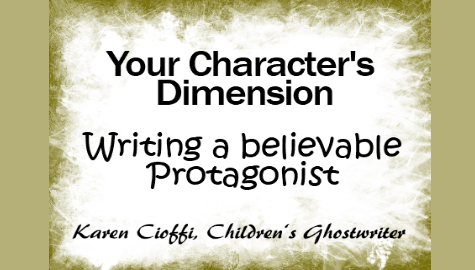
Is your protagonist one, two, or three dimensional?
Between your characters and the plot, you develop a story. If the mix is right and the characters are believable, you can create a story worthy of publication.
While there are many articles about creating believable characters, it’s an important topic, and reminders are always in order since your characters are a crucial aspect of your story.
So, which is your protagonist?
1. Is your protagonist flat? Does he lack emotions, a backstory, and action. Is he like the simple and safe kiddy ride at a children’s amusement park, the carousel horse that goes round and round, but does nothing else?
Then, you have a one-dimensional character on your hands. He doesn’t have a character arc. No depth. No growth.
2. Is your protagonist a little bumpy. Does he have some quirks, life, and emotion, but no real depth of character or history. Is she like the carousel horse that goes round and round and up and down at a steady, easy pace?
Then. you have a two-dimensional character struggling to break into the world of believability. This character has an arc, but it’s weak.
3. Is your protagonist a full-blown amusement park. Is he like a roller coaster, full of ups and downs, knowledge, emotion, character, quirks, motivation, life, and history?
Now you have it—you have a believable three-dimensional character that is strong enough to bring your story through to the end.
Now the question is: how do you create a wonderful, believable life-like three-dimensional character?
There are a number of methods you can use that will help create a believable character, here are two:
1. Create a character sheet or use an index card before you begin.
On your sheet, list all the characteristics, quirks, moods, mannerisms, physical, artistic, and intellectual attributes; you get the idea. Keep this sheet handy as you’re writing your story.
If you tell the reader Pete has blonde hair at the beginning of the story, and then you describe it as black, stay true to the story unless he dyed his hair as part of the storyline. Readers pick up on errors very quickly.
The more detail you add to your character sheet, the easier it will be to know what your protagonist will do in any given circumstance. Adding these details will take the element of wondering out of your writing process and save time..
Say Pete finds a bag of money next to his neighbor’s car. Hmm… Will he keep it or try to find out if it’s his neighbor’s?
Oh, wait a minute. On your character sheet you wrote that he’s an honest guy! Simple.
2. Add characteristics, attributes, and emotions to your protagonist as you write your story.
Write your protagonist’s characteristics, quirks, moods, mannerisms, and so on, on a character sheet as your story evolves.
Every write has their own method of creating a story. Maybe you use the seat-of-the-pants method, and your character evolves as your story does. With this method, you want to be sure to note each new development in your protagonist’s character or being.
Let’s go back to Pete again. Pete scratches a car with his bicycle. Does he leave a note on the car he damaged? Does he quickly leave the scene? Does Pete just go about his business, ignoring the incident?
While he’s usually honest, he could have a moment of weakness. Maybe he’s afraid of the consequences.
Whichever of these actions Pete chooses will establish another element to his character – be sure to make note of it.
No matter what process you use, remember to add life-like qualities to your character. These qualities include motivations and struggles, whether internal or external. Readers need to develop a relationship with the protagonist. If they feel Pete is three-dimensional and they are drawn to him, they’ll be sure to read to the end of your book.

I’m a working children’s ghostwriter, rewriter, editor, and coach. I can help turn your story into a book you’ll be proud to be the author of, one that’s publishable and marketable.
OTHER HELP I OFFER:
HOW TO WRITE A CHILDREN’S FICTION BOOK
A DIY book to help you write your own children’s book.
PICTURE, CHAPTER, AND MIDDLE GRADE BOOK COACHING
Four to ten-week coaching programs.
WRITERS ON THE MOVE SELF-PUBLISHING HELP
Self-publishing help for children’s authors.
CREATING AN AUTHOR ONLINE PLATFORM
Step-by-step with a former WOW! Women on Writing author online platform instructor.
You can contact me at: kcioffiventrice@gmail.com. Or give me a call at 347—834—6700. (Please leave a message- I’ll get back to you as soon as I can.)
http://karencioffiwritingforchildren.com/2016/04/24/the-one-sentence-pitch-for-your-manuscript/
http://karencioffiwritingforchildren.com/2016/04/17/how-do-you-build-a-successful-writing-career-3-tips/
http://karencioffiwritingforchildren.com/2016/03/20/8-top-fiction-writing-mistakes-to-avoid/


1 thought on “Is Your Protagonist Multi-Dimensional?”